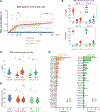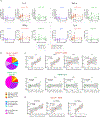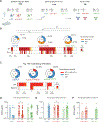AS03 adjuvant enhances the magnitude, persistence, and clonal breadth of memory B cell responses to a plant-based COVID-19 vaccine in humans
- PMID: 38579013
- PMCID: PMC11732256
- DOI: 10.1126/sciimmunol.adi8039
AS03 adjuvant enhances the magnitude, persistence, and clonal breadth of memory B cell responses to a plant-based COVID-19 vaccine in humans
Abstract
Vaccine adjuvants increase the breadth of serum antibody responses, but whether this is due to the generation of antigen-specific B cell clones with distinct specificities or the maturation of memory B cell clones that produce broadly cross-reactive antibodies is unknown. Here, we longitudinally analyzed immune responses in healthy adults after two-dose vaccination with either a virus-like particle COVID-19 vaccine (CoVLP), CoVLP adjuvanted with AS03 (CoVLP+AS03), or a messenger RNA vaccination (mRNA-1273). CoVLP+AS03 enhanced the magnitude and durability of circulating antibodies and antigen-specific CD4+ T cell and memory B cell responses. Antigen-specific CD4+ T cells in the CoVLP+AS03 group at day 42 correlated with antigen-specific memory B cells at 6 months. CoVLP+AS03 induced memory B cell responses, which accumulated somatic hypermutations over 6 months, resulting in enhanced neutralization breadth of monoclonal antibodies. Furthermore, the fraction of broadly neutralizing antibodies encoded by memory B cells increased between day 42 and 6 months. These results indicate that AS03 enhances the antigenic breadth of B cell memory at the clonal level and induces progressive maturation of the B cell response.
Conflict of interest statement
Competing interests
B.P. serves on the External Immunology Board of GlaxoSmithKline, and on the Scientific Advisory Board of Sanofi, Medicago, CircBio, Boehringer-Ingelheim, Icosavax, and EdJen. M.S.S. serves in a consulting role for Moderna and Ocugen. S.P., N.C. and B.J.W. are employees of Medicago. All other authors declare no competing interests.
Figures





References
-
- Cao Y, Yisimayi A, Jian F, Song W, Xiao T, Wang L, Du S, Wang J, Li Q, Chen X, Yu Y, Wang P, Zhang Z, Liu P, An R, Hao X, Wang Y, Wang J, Feng R, Sun H, Zhao L, Zhang W, Zhao D, Zheng J, Yu L, Li C, Zhang N, Wang R, Niu X, Yang S, Song X, Chai Y, Hu Y, Shi Y, Zheng L, Li Z, Gu Q, Shao F, Huang W, Jin R, Shen Z, Wang Y, Wang X, Xiao J, Xie XS, BA.2.12.1, BA.4 and BA.5 escape antibodies elicited by Omicron infection. Nature 608, 593–602 (2022). - PMC - PubMed
-
- Cele S, Jackson L, Khoury DS, Khan K, Moyo-Gwete T, Tegally H, San JE, Cromer D, Scheepers C, Amoako DG, Karim F, Bernstein M, Lustig G, Archary D, Smith M, Ganga Y, Jule Z, Reedoy K, Hwa S-H, Giandhari J, Blackburn JM, Gosnell BI, Abdool Karim SS, Hanekom W, NGS-SA, M.-A. Davies, Hsiao M, Martin D, Mlisana K, Wibmer CK, Williamson C, York D, COMMIT-KZN Team, Harrichandparsad R, Herbst K, Jeena P, Khoza T, Kløverpris H, Leslie A, Madansein R, Magula N, Manickchund N, Marakalala M, Mazibuko M, Moshabela M, Mthabela N, Naidoo K, Ndhlovu Z, Ndung’u T, Ngcobo N, Nyamande K, Patel V, Smit T, Steyn A, Wong E, von Gottberg A, Bhiman JN, Lessells RJ, Moosa M-YS, Davenport MP, de Oliveira T, Moore PL, Sigal A, Omicron extensively but incompletely escapes Pfizer BNT162b2 neutralization. Nature 602, 654–656 (2022). - PMC - PubMed
-
- Liu C, Ginn HM, Dejnirattisai W, Supasa P, Wang B, Tuekprakhon A, Nutalai R, Zhou D, Mentzer AJ, Zhao Y, Duyvesteyn HME, López-Camacho C, Slon-Campos J, Walter TS, Skelly D, Johnson SA, Ritter TG, Mason C, Costa Clemens SA, Gomes Naveca F, Nascimento V, Nascimento F, Fernandes da Costa C, Resende PC, Pauvolid-Correa A, Siqueira MM, Dold C, Temperton N, Dong T, Pollard AJ, Knight JC, Crook D, Lambe T, Clutterbuck E, Bibi S, Flaxman A, Bittaye M, Belij-Rammerstorfer S, Gilbert SC, Malik T, Carroll MW, Klenerman P, Barnes E, Dunachie SJ, Baillie V, Serafin N, Ditse Z, Da Silva K, Paterson NG, Williams MA, Hall DR, Madhi S, Nunes MC, Goulder P, Fry EE, Mongkolsapaya J, Ren J, Stuart DI, Screaton GR, Reduced neutralization of SARS-CoV-2 B.1.617 by vaccine and convalescent serum. Cell 184, 4220–4236.e13 (2021). - PMC - PubMed
Publication types
MeSH terms
Substances
Grants and funding
LinkOut - more resources
Full Text Sources
Medical
Research Materials

